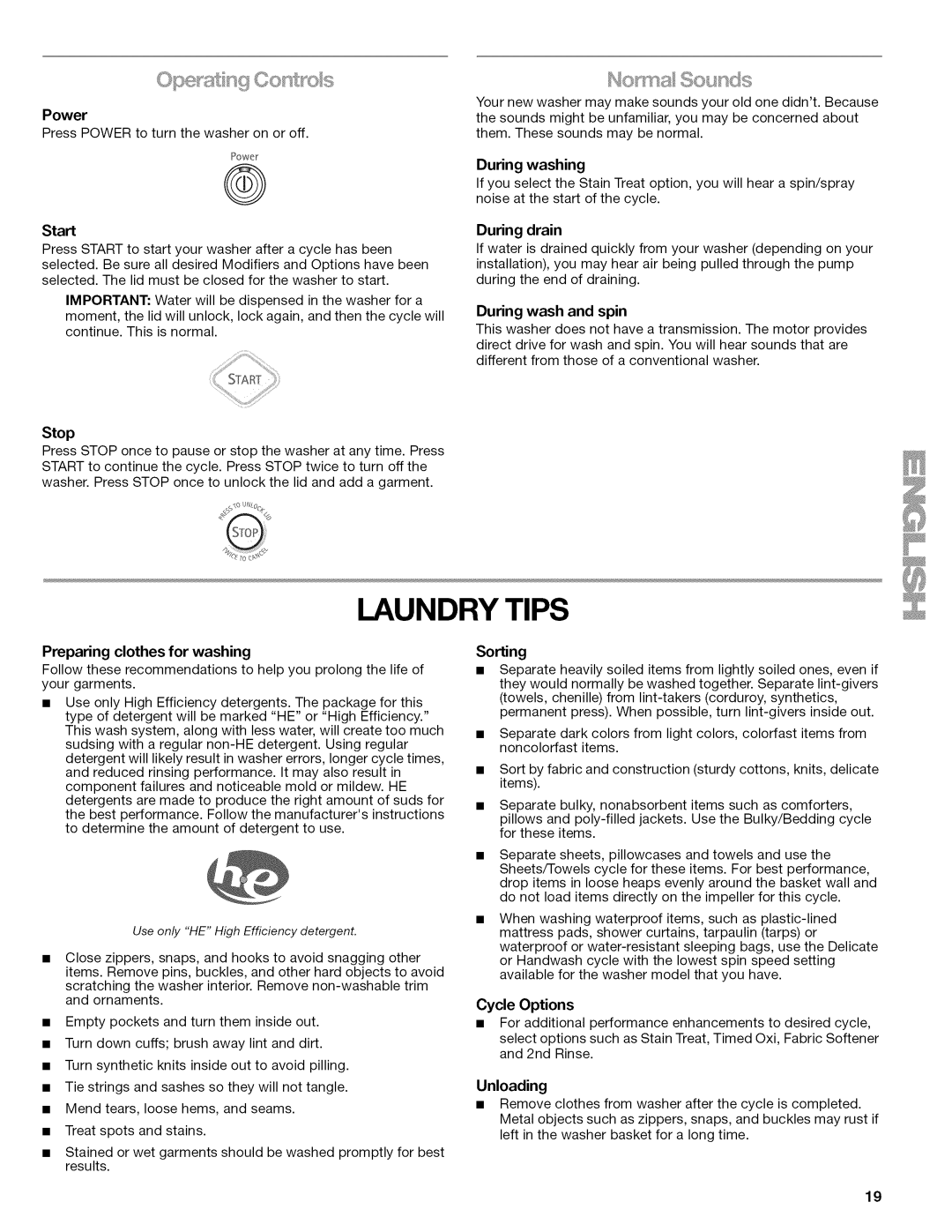WIOO26626B
Oasis HT
Protection Agreements
Table of Contents
Kenmore Elite Appliance Warranty
Washer Safety
Explosive
Installation Requirements
If You Have You Will Need to Buy
Alternate Parts
Standpipe drain system--wall or floor views a & B
Electrical Shock Hazard
Grounding iNSTRUCTiONS
Laundry tub drain system view C
Floor drain system view D
Remove drain hose from washer cabinet
Installation Instructions
To keep drain water from going back into the washer
Floor drain
Connect the inlet hoses to the water faucets
Connect the inlet hoses to the washer
Check for leaks
Lew e e
Plug into a grounded 3 prong outlet
Benefits and Features
Save Energy Plus Option
Delay Start
End of Cycle Signal
Force Filter Wash/Rinse System
Fire Hazard
Washer USE
Changing Cycles during the wash cycle
Add a Garment
To add a garment or pause the washer at any time
To restart the washer
To use the preset cycle settings
Clothes Clean
Indicator lights
Preset Cycle Settings
Casual/Wrinkle Free
When to use Rinse & Spin
Heavy Duty
Normal
Soil Level Wash Time
Drain & Spin
Save Energy Plus
To cancel Delay Start
Cycle Signal Volume
Stain Treat Catalyst Cleaning Action
Laundry Tips
Always do the following to maintain washer freshness
Washer Care
Use only High Efficiency HEdetergent for your wash loads
Troubleshooting
Are you washing items with metal snaps, buckles or zippers?
Is the washer gurgling or humming?
Are you washing a small load?
Washer basket moves while washing. This is normal
Is there oversudsing?
Are the hot and cold water faucets turned on?
Is the washer in a normal pause in the cycle?
Is the washer overloaded?
Stains, gray whites, dingy colors
Residue or lint on load
Garments damaged
Page
Contratos DE Proteccion
Ndice
Registro DEL Producto
Garanta DE LOS Electrodomi Sticos Kenmore Elite
GARANTiA Limitada DE UN Aiio
Exclusion DE Garantias Implicitas Limitacion DE Recursos
EL GAS Hidrogeno
Seguridad DE LA Lavadora
Ses sn
Requisitos DE Instalacion
Piezas suministradas
Sistema de desagLie por la tina del lavadero vista C
Ems de desaqCie
Sistema de desagLie por el piso vista D
Para una lavadora conectada a tierra con cable el6etrico
Instrucciones Para LA Conexisn Tierra
IM PO Rtante
Instrucciones DE Instalacion
S82scS@co#s@lqi/lt
Quite la manguera de desagie de la carcasa de la lavadora
Para evitar que el agua de desagLie vuelva a su lavadora
DesagLie por el piso
Conecte las mangueras de entrada a la lavadora
Conecte las mangueras de entrada a los grifos de agua
WSC 6 de s......@v......SS£S
Sc @ de a ms sgue a de dssg e
Revise si hay fugas
Peligro de Choque EI6ctrico
Agitador Invizible TM
Nivel automtico del agua
Detergente de alto rendimiento HE
Control automtico de temperatura CAT
Sistema de lavado/enjuague con filtro de fuerza
Inicio diferido Delay Start
USO DE LA Lavadora
Use de d@@x0ente adecusdo
Para reanudar la marcha de la lavadora
Notas
Ropa delicada
Blancos
Blanquisimos
Free Lavado Expreso Ligero
Articulos voluminosos/Ropa de cama Bulky/Bedding
Intenso Heavy Duty
Informal/Sin arrugas Casual/Wrinkle Free
Lavado expreso Express Wash
Nivel de suciedad tiempo de lavado
Limpiar la lavadora Clean Washer
Desagie y exprimido Drain & Spin
Para usar el ajuste de desagOe y exprimido
Temperatura de lavado/enjuague
Volumen de la serial de ciclo
Oprima POWERpara encender o apagar la lavadora
Encendido Power
Co es de onam
Opciones de ciclos
Consejos DE Lavandera
Preparacibn de la ropa para lavar
Selecci6n de la ropa
Cuidado durante las vacaciones y periodos sin uso
Cuidado DE LA Lavadora
Procedimiento para el mantenimiento de la lavadora
Comience el procedimiento
Solucion DE Problemas
La lavadora pierde agua
Ruidosos, vibrantes, desequilibrados
Esta la lavadora en una pausa normal en el ciclo?
Temperatura de lavado/enjuague
Esta sobrecargada la lavadora?
Esta la temperatura del agua por debajo de los 60F 15,6C?
Exceso de espuma
Esta lavando muchas cargas?
Ha separado la ropa adecuadamente?
Manchas, ropa blanca percudida, colores opacos
Contrats DE Protection
Table DES Matii RES
Garantie Limitie DE UN AN
Garantie DES Appareils MI Nagers Kenmore Elite
Enregistrement DU Produit
Votre securite et celle des autres est tres importante
SI Curiti DE LA Laveuse
Si vous avez Vous devrez acheter
Exigences Dinstallation
Pices fournies
Autres pices
ABC
Systme de vidange avec vier de buanderie vue C
Systme de vidange au plancher vue D
Pour une laveuse raccorde en permanence
Risque du poids excessif
Instructions Dinstallation
Raccordement des tuyaux dalimentation & la laveuse
Racc£ie J se t des tuy ux d a ruests @s
Recherche de fuites
Ress se se s oomb Sveuse
Contr61erIaplomb sur le c6t
IS@J@ !Stiis 3£
Niveau deau automatique
Commande automatique de la temperature CAT
Programme Clean Washer nettoyage de la laveuse
Systme de lavage Haute efficacit gentlewash TM
Utilisation DE LA Laveuse
Add a Garment ajouter un v6tement
I8 18 lw,,,=c@
Pour remettre la laveuse en marche
Remarques
Free
Heavy Duty service
Heavy Duty service intense
Minutes Niveau de Temp Salet Lavage Rgles Rinage
Main parce que
Clean Washer nettoyage de la laveuse
Sheets/Towels draps/serviettes
Darks/Colors articles foncs/couleurs
Cold Froide
Auto Temp Control commande automatique de la temperature
Soil Level/Niveau de salet dure de lavage
Spin Speed vitesse dessorage
Save Energy Plus conomie dnergie Plus
Cycle Signal Volume volume du signal de fin de programme
Pour modifier Iheure de raise en marche diffre
Pour annuler la raise en marche diffre
Stop arr6t
Power alimentation
Appuyer sur Power pour allumer ou eteindre la laveuse
8o snme des comma des
Dchargement
Conseils DE Lessivage
Preparation des vtements pour le lavage
Options de programme
Utiliser uniquement un detergent Haute efficacite HE
Procedure dentretien de la laveuse
Dbut de la procedure
Entretien DE LA Laveuse
Transport de la laveuse
Rinstallation de la laveuse
Remise en marche de la laveuse
Ne pas utiliser un c&ble de rallonge
Depannage
Lavez-vous une petite charge?
La laveuse fuit
Javel/Oxi?
FOsdosnementde a s use
Avez-vous utilis un rinage a froid?
Possdez-vous une laveuse Energy STAR?
Avez-vous slectionn Ioption Stain Treat?
Excs de mousse Avez-vous utilis un dtergent non-HE?
Endommagement des v6tements
Taches, blancs gris&tres, couleurs dfraichies
Sears

